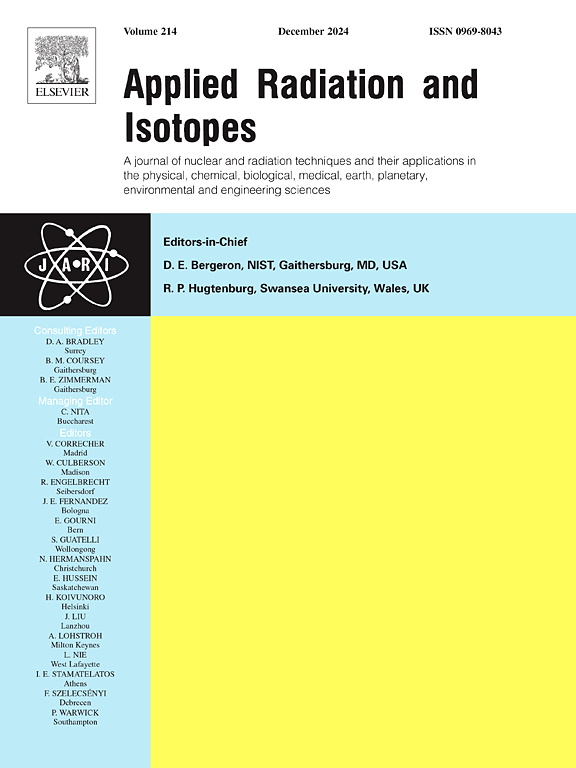Investigation of experimental and simulated gamma ray shielding features of pure Sm2O3 and yttrium doped Sm2O3 nanoparticles
IF 1.6
3区 工程技术
Q3 CHEMISTRY, INORGANIC & NUCLEAR
引用次数: 0
Abstract
In recent years, the development of alternative materials to lead for environmentally friendly and non-toxic radiation shielding has garnered significant interest. This study focuses on synthesizing pure samarium oxide (Sm2O3) and yttrium-doped Sm2O3 nanostructures (with 10 % and 20 % yttrium) using the sol-gel method as potential lead-free radiation shielding materials. The structural, optical, and morphological properties were analyzed using Energy Dispersive X-ray Spectroscopy (EDS), X-ray Diffraction (XRD), Diffuse Reflectance Spectroscopy (DRS), Fourier Transform Infrared Spectroscopy (FTIR), Photoluminescence Spectroscopy (PL) and Field Emission Scanning Electron Microscopy (FESEM). XRD confirmed a cubic crystal structure for Sm2O3, with yttrium incorporation causing slight structural modifications. FESEM images highlighted the interaction between yttrium nanoplates and Sm2O3 nanorods, while EDS confirmed the expected elemental composition. Key gamma shielding parameters—including mean free path (MFP), mass attenuation coefficients (MAC), linear attenuation coefficients (LAC), transmission factor (TF), tenth value layer (TVL), half value layer (HVL) and radiation protection efficiency (RPE) —were experimentally measured and simulated using GEometry ANd Tracking (GEANT4) toolkit. The results demonstrated that the addition of yttrium enhanced radiation shielding performance. The LAC values for pure Sm2O3 (SY0), 10 % (SY1) and 20 % (SY2) yttrium-doped samples were 2.1070, 2.1622 and 2.2058, respectively. The HVL, TVL, MFP and TF exhibited a decreasing trend. The GEANT4 simulations confirmed these findings, showing gamma attenuation percentages of 25.21 %, 25.79 % and 26.24 % for the respective samples. The study suggests that Sm2O3/yttrium composites can serve as efficient gamma shielding materials.
纯Sm2O3和掺钇Sm2O3纳米颗粒屏蔽γ射线的实验和模拟研究
近年来,开发铅的环保、无毒辐射屏蔽材料引起了人们的极大兴趣。本研究的重点是利用溶胶-凝胶法合成纯氧化钐(Sm2O3)和掺钇Sm2O3纳米结构(含10%和20%钇)作为潜在的无铅辐射屏蔽材料。利用能量色散x射线能谱(EDS)、x射线衍射(XRD)、漫反射光谱(DRS)、傅里叶变换红外光谱(FTIR)、光致发光光谱(PL)和场发射扫描电镜(FESEM)分析了材料的结构、光学和形态特性。XRD证实Sm2O3为立方晶体结构,钇的掺入引起了轻微的结构改变。FESEM图像突出了钇纳米板和Sm2O3纳米棒之间的相互作用,而EDS证实了预期的元素组成。利用GEANT4工具对主要屏蔽参数——平均自由程(MFP)、质量衰减系数(MAC)、线性衰减系数(LAC)、透射系数(TF)、第十值层(TVL)、半值层(HVL)和辐射防护效率(RPE)进行了实验测量和模拟。结果表明,钇的加入增强了辐射屏蔽性能。纯Sm2O3 (SY0)、10% (SY1)和20% (SY2)掺钇样品的LAC值分别为2.1070、2.1622和2.2058。HVL、TVL、MFP和TF呈下降趋势。GEANT4模拟证实了这些发现,显示各自样品的伽马衰减百分比分别为25.21%,25.79%和26.24%。研究表明,Sm2O3/钇复合材料可以作为有效的屏蔽材料。
本文章由计算机程序翻译,如有差异,请以英文原文为准。
求助全文
约1分钟内获得全文
求助全文
来源期刊

Applied Radiation and Isotopes
工程技术-核科学技术
CiteScore
3.00
自引率
12.50%
发文量
406
审稿时长
13.5 months
期刊介绍:
Applied Radiation and Isotopes provides a high quality medium for the publication of substantial, original and scientific and technological papers on the development and peaceful application of nuclear, radiation and radionuclide techniques in chemistry, physics, biochemistry, biology, medicine, security, engineering and in the earth, planetary and environmental sciences, all including dosimetry. Nuclear techniques are defined in the broadest sense and both experimental and theoretical papers are welcome. They include the development and use of α- and β-particles, X-rays and γ-rays, neutrons and other nuclear particles and radiations from all sources, including radionuclides, synchrotron sources, cyclotrons and reactors and from the natural environment.
The journal aims to publish papers with significance to an international audience, containing substantial novelty and scientific impact. The Editors reserve the rights to reject, with or without external review, papers that do not meet these criteria.
Papers dealing with radiation processing, i.e., where radiation is used to bring about a biological, chemical or physical change in a material, should be directed to our sister journal Radiation Physics and Chemistry.
 求助内容:
求助内容: 应助结果提醒方式:
应助结果提醒方式:


